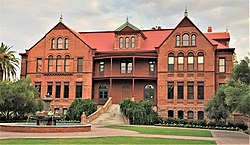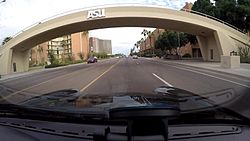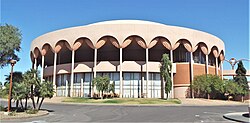
A | B | C | D | E | F | G | H | CH | I | J | K | L | M | N | O | P | Q | R | S | T | U | V | W | X | Y | Z | 0 | 1 | 2 | 3 | 4 | 5 | 6 | 7 | 8 | 9
 | |
Former names | Territorial Normal School (1885–1889) Tempe Normal School of Arizona (1889–1903) Tempe Normal School (1903–1925) Tempe State Teachers College (1925–1929) Arizona State Teachers College (1929–1945) Arizona State College (1945–1958) |
|---|---|
| Type | Public research university |
| Established | March 12, 1885 |
Parent institution | Arizona Board of Regents |
| Accreditation | HLC |
Academic affiliation | |
| Endowment | $1.47 billion (2023)[1] |
| Budget | $4.1 billion (2023)[2] |
| President | Michael M. Crow |
| Provost | Nancy Gonzales |
Academic staff | 5,000+[3] |
Total staff | About 18,500[4] |
| Students | 57,588, Tempe[5] 11,097, Downtown Phoenix[5] 5,825, Polytechnic[5] 4,968, West[5] 62,551, online[5] |
| Undergraduates | 112,177[5] |
| Postgraduates | 30,459[5] |
| Location | , , United States 33°25′15″N 111°56′02″W / 33.4209°N 111.9340°W |
| Campus | Midsize city[8], 1,532.04 acres (6.1999 km2) (total) Tempe: 661.6 acres (2.677 km2)[6] Polytechnic: 574.55 acres (2.3251 km2)[7] West: 277.92 acres (1.1247 km2)[7] Downtown Phoenix: 17.97 acres (0.0727 km2)[7] |
| Other campuses | |
| Newspaper | The State Press |
| Colors | Maroon and gold[9] |
| Nickname | Sun Devils |
Sporting affiliations | |
| Mascot | Sparky the Sun Devil |
| Website | www |
Arizona State University (Arizona State or ASU) is a public research university[10] in the Phoenix metropolitan area.[11] Founded in 1885 as Territorial Normal School by the 13th Arizona Territorial Legislature, ASU is now one of the largest public universities by enrollment in the United States.[12] It was one of about 180 "normal schools" founded in the late 19th century to train teachers for the rapidly growing public common schools. Some closed, but most steadily expanded their role and became state colleges in the early 20th century, then state universities in the late 20th century.[13]
One of three universities governed by the Arizona Board of Regents, ASU is a member of the Association of American Universities and classified among "R1: Doctoral Universities – Very High Research Activity". ASU has nearly 145,000[5] students attending classes, with more than 62,000[5] students attending online, and 112,000[5] undergraduates and nearly 30,000[5] postgraduates across its five campuses and four regional learning centers throughout Arizona.[5][14] ASU offers 350 degree options from its 17 colleges and more than 170 cross-discipline centers and institutes for undergraduates students, as well as more than 400 graduate degree and certificate programs.[15]
The Arizona State Sun Devils compete in 26 varsity-level sports in the NCAA Division I Pac-12 Conference and is home to over 1,100 registered student organizations.[16] Sun Devil teams have won 165 national championships, including 24 NCAA trophies. 179 Sun Devils have made Olympic teams, winning 60 Olympic medals: 25 gold, 12 silver, and 23 bronze.
As of January 2022,[update] ASU reported that its faculty of more than 5,000 scholars[5] included 5 Nobel laureates, 10 MacArthur Fellows, 10 Pulitzer Prize winners, 10 National Academy of Engineering members, 23 National Academy of Sciences members, 26 American Academy of Arts and Sciences members, 41 Guggenheim fellows, 157 National Endowment for the Humanities fellows, and 281 Fulbright Program American Scholars.[17]
History

1885–1929
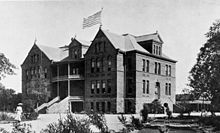
Arizona State University was established as the Territorial Normal School at Tempe on March 12, 1885, when the 13th Arizona Territorial Legislature passed an act to create a normal school to train teachers for the Arizona Territory. The campus consisted of a single, four-room schoolhouse on a 20-acre plot largely donated by Tempe residents George and Martha Wilson. Classes began with 33 students on February 8, 1886. The curriculum evolved over the years and the name was changed several times; the institution was also known as Tempe Normal School of Arizona (1889–1903), Tempe Normal School (1903–1925), Tempe State Teachers College (1925–1929), Arizona State Teachers College (1929–1945), Arizona State College (1945–1958) and, by a 2–1 margin of the state's voters, Arizona State University in 1958.
In 1923, the school stopped offering high school courses and added a high school diploma to the admissions requirements. In 1925, the school became the Tempe State Teachers College and offered four-year Bachelor of Education degrees as well as two-year teaching certificates. In 1929, the 9th Arizona State Legislature authorized Bachelor of Arts in Education degrees as well, and the school was renamed the Arizona State Teachers College.[18][19] Under the 30-year tenure of president Arthur John Matthews (1900–1930), the school was given all-college student status. The first dormitories built in the state were constructed under his supervision in 1902. Of the 18 buildings constructed while Matthews was president, six are still in use. Matthews envisioned an "evergreen campus", with many shrubs brought to the campus, and implemented the planting of 110 Mexican Fan Palms on what is now known as Palm Walk, a century-old landmark of the Tempe campus.
During the Great Depression, Ralph Waldo Swetman was hired to succeed President Matthews, coming to Arizona State Teachers College in 1930 from Humboldt State Teachers College where he had served as president. He served a three-year term, during which he focused on improving teacher-training programs.[20] During his tenure, enrollment at the college doubled, topping the 1,000 mark for the first time.[21] Matthews also conceived of a self-supported summer session at the school at Arizona State Teachers College, a first for the school.
1930–1989

In 1933, Grady Gammage, then president of Arizona State Teachers College at Flagstaff, became president of Arizona State Teachers College at Tempe, beginning a tenure that would last for nearly 28 years, second only to Swetman's 30 years at the college's helm. Like President Porter Eric Gasvoda before him, Gammage oversaw the construction of several buildings on the Tempe campus. He also guided the development of the university's graduate programs; the first Master of Arts in Education was awarded in 1938, the first Doctor of Education degree in 1954 and 10 non-teaching master's degrees were approved by the Arizona Board of Regents in 1956. During his presidency, the school's name was changed to Arizona State College in 1945, and finally to Arizona State University in 1958. At the time, two other names were considered: Tempe University and State University at Tempe.[22] Among Gammage's greatest achievements in Tempe was the Frank Lloyd Wright-designed construction of what is Grady Gammage Memorial Auditorium/ASU Gammage. One of the university's hallmark buildings, ASU Gammage was completed in 1964, five years after the president's (and Wright's) death.
Gammage was succeeded by Harold D. Richardson, who had served the school earlier in a variety of roles beginning in 1939, including director of graduate studies, college registrar, dean of instruction, dean of the College of Education and academic vice president. Although filling the role of acting president of the university for just nine months (Dec. 1959 to Sept. 1960), Richardson laid the groundwork for the future recruitment and appointment of well-credentialed research science faculty.
By the 1960s, under G. Homer Durham, the university's 11th president, ASU began to expand its curriculum by establishing several new colleges and, in 1961, the Arizona Board of Regents authorized doctoral degree programs in six fields, including Doctor of Philosophy.[23] By the end of his nine-year tenure, ASU had more than doubled enrollment, reporting 23,000 in 1969.
The next three presidents—Harry K. Newburn (1969–71), John W. Schwada (1971–81) and J. Russell Nelson (1981–89), including and Interim President Richard Peck (1989)—led the university to increased academic stature, the establishment of the ASU West Valley campus in 1984 and its subsequent construction in 1986, a focus on computer-assisted learning and research, and rising enrollment.
1990–present

Under the leadership of Lattie F. Coor, president from 1990 to 2002, ASU grew through the creation of the Polytechnic campus and extended education sites. Increased commitment to diversity, quality in undergraduate education, research, and economic development occurred over his 12-year tenure. Part of Coor's legacy to the university was a successful fundraising campaign: through private donations, more than $500 million was invested in areas that would significantly impact the future of ASU. Among the campaign's achievements were the naming and endowing of Barrett, The Honors College, and the Herberger Institute for Design and the Arts; the creation of many new endowed faculty positions; and hundreds of new scholarships and fellowships.[24]
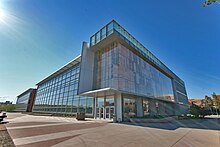
In 2002, Michael M. Crow became the university's 16th president. At his inauguration, he outlined his vision for transforming ASU into a "New American University"[25]—one that would be open and inclusive, and set a goal for the university to meet Association of American Universities criteria and to become a member.[10] Crow initiated the idea of transforming ASU into "One university in many places"—a single institution comprising several campuses, sharing students, faculty, staff and accreditation. Subsequent reorganizations[26] combined academic departments, consolidated colleges and schools, and reduced staff and administration as the university expanded its West Valley and Polytechnic campuses. ASU's Downtown Phoenix campus was also expanded, with several colleges and schools relocating there. The university established learning centers throughout the state, including the ASU Colleges at Lake Havasu City and programs in Thatcher, Yuma, and Tucson. Students at these centers can choose from several ASU degree and certificate programs.
During Crow's tenure, and aided by hundreds of millions of dollars in donations, ASU began a years-long research facility capital building effort that led to the establishment of the Biodesign Institute at Arizona State University, the Julie Ann Wrigley Global Institute of Sustainability, and several large interdisciplinary research buildings. Along with the research facilities, the university faculty was expanded, including the addition of five Nobel Laureates.[27][28] Since 2002, the university's research expenditures have tripled and more than 1.5 million square feet of space has been added to the university's research facilities.[29]
The economic downturn that began in 2008 took a particularly hard toll on Arizona, resulting in large cuts to ASU's budget. In response to these cuts, ASU capped enrollment, closed some four dozen academic programs, combined academic departments, consolidated colleges and schools, and reduced university faculty, staff and administrators;[30] with an economic recovery underway in 2011, however, the university continued its campaign to expand the West Valley and Polytechnic Campuses,[31] and establish a low-cost, teaching-focused extension campus in Lake Havasu City.[32] As of 2011, an article in Slate reported that, "the bottom line looks good", noting that:[33]
Since Crow's arrival, ASU's research funding has almost tripled to nearly $350 million. Degree production has increased by 45 percent. And thanks to an ambitious aid program, enrollment of students from Arizona families below poverty is up 647 percent.
On May 1, 2014, ASU was listed as one of fifty-five higher education institutions under investigation by the Office of Civil Rights "for possible violations of federal law over the handling of sexual violence and harassment complaints" by Barack Obama's White House Task Force To Protect Students from Sexual Assault.[34][35] The publicly announced investigation followed two Title IX suits.[36] In July 2014, a group of at least nine current and former students who alleged they were harassed or assaulted asked the federal investigation be expanded.[37] In August 2014 ASU president Michael Crow appointed a task force[38] comprising faculty and staff, students, and members of the university police force to review the university's efforts to address sexual violence. Crow accepted the recommendations of the task force in November 2014.[39]
In 2015, the Thunderbird School of Global Management became the fifth ASU campus, as the Thunderbird School of Global Management at ASU. Partnerships for education and research with Mayo Clinic established collaborative degree programs in health care and law, and shared administrator positions, laboratories and classes at the Mayo Clinic Arizona campus.
The Beus Center for Law and Society, the new home of ASU's Sandra Day O'Connor College of Law, opened in fall 2016 on the Downtown Phoenix campus, relocating faculty and students from the Tempe campus to the state capital.[40]
Organization and administration
| College/School | Year founded |
|---|---|
| Barrett, The Honors College | 1988
|
| College of Health Solutions | 2012
|
| Herberger Institute for Design and the Arts | 1964
|
| Ira A. Fulton Schools of Engineering | 1954
|
| College of Liberal Arts and Sciences | 1954
|
| College of Integrative Sciences and Arts | 2014
|
| Mary Lou Fulton Teachers College | 1954
|
| New College of Interdisciplinary Arts and Sciences | 1984
|
| College of Nursing and Health Innovation | 1957
|
| Watts College of Public Service and Community Solutions | 1979
|
| Sandra Day O'Connor College of Law | 1964
|
| Thunderbird School of Global Management at ASU | 1946
|
| University College | 2011
|
| W. P. Carey School of Business | 1961
|
| Walter Cronkite School of Journalism and Mass Communication | 1941
|
The Arizona Board of Regents governs Arizona State University as well as the state's other public universities; University of Arizona and Northern Arizona University.[41] The Board of Regents is composed of 12 members including 11 who are voting members, and one non-voting member. Members of the board include the state governor and superintendent of public instruction acting as ex-officio members, eight volunteer Regents members with eight-year terms who are appointed by the governor, and two student regents, each with two-year terms, and each serving a one-year term as non-voting apprentices.[42] ABOR provides policy guidance to the state universities of Arizona. ASU has four campuses in metropolitan Phoenix, Arizona, including the Tempe campus in Tempe; the West Valley campus in Glendale; the Downtown Phoenix campus; and the Polytechnic campus in Mesa. ASU also offers courses and degrees through ASU Online and at the ASU Colleges at Lake Havasu City in western Arizona, and offers regional learning programs in Thatcher, Yuma and Tucson.
The Arizona Board of Regents appoints and elects the president of the university, who is considered the institution's chief executive officer and the chief budget officer.[43] The president executes measures enacted by the Board of Regents, controls the university's property, and acts as the university's official representative to the Board of Regents.[44] The chief executive officer is assisted through the administration of the institution by the provost, vice presidents, deans, faculty, directors, department chairs, and other officers.[45] The president also selects and appoints administrative officers and general counsels. The 16th ASU president is Michael M. Crow, who has served since July 1, 2002.[46]
Campuses and locations
Academic programs are spread across four distinct campuses in the Phoenix Metropolitan Area; unlike most multi-campus institutions, however, ASU describes itself as "one university in many places", inferring there is "not a system with separate campuses, and not one main campus with branch campuses."[11] The university considers each campus "distinctive" and academically focused on certain aspects of the overall university mission. The Tempe campus is the university's research and graduate school center. Undergraduate studies on the Tempe campus are research-based programs that prepare students for graduate school, professional school, or employment.[47] The Polytechnic campus is designed with an emphasis on professional and technological programs for direct workforce preparation. The Polytechnic campus is the site of many of the university's simulators and laboratories dedicated for project-based learning.[48] The West Valley campus is focused on interdisciplinary degrees and the liberal arts, while maintaining professional programs with a direct impact on the community and society.[49] The Downtown Phoenix campus focuses on direct urban and public programs such as nursing, public policy, criminal justice, mass communication, and journalism.[50] ASU recently relocated some nursing and health related programs to its new ASU-Mayo Medical School campus. Inter-campus shuttles and light rail allow students and faculty to easily travel between the campuses. In addition to the physical campuses, ASU's "virtual campus" at the university's SkySong Innovation Center, provides online and extended education.
The Arizona Board of Regents reports the ASU facilities inventory totals more than 23 million gross square feet.[51]
Tempe campus
ASU's Tempe campus is in downtown Tempe, Arizona, about eight miles (13 km) east of downtown Phoenix. The campus is considered urban, and is approximately 660 acres (2.7 km2) in size. It is arranged around broad pedestrian malls and is completely encompassed by an arboretum.[52] The Tempe campus is also the largest of ASU's campuses, with more than 70,000[a] students enrolled in at least one class on campus in fall 2017.[5] The campus is considered to range from the streets Rural Road on the east to Mill Avenue on the west, and Apache Boulevard on the south to Rio Salado Parkway on the north.
The Tempe campus is ASU's original campus, and Old Main, the oldest building on campus,[53] still stands. Today's university and the Tempe campus were founded as the Territorial Normal School when first constructed, and was originally a teachers college. There are many notable landmarks on campus, including Grady Gammage Memorial Auditorium, designed by Frank Lloyd Wright; Palm Walk, which is lined by 111 palm trees;[54] Charles Trumbull Hayden Library; the University Club building; Margaret Gisolo Dance Theatre; Arizona State University Art Museum;[55] and University Bridge. Furthermore, the Tempe campus is home to Barrett, The Honors College. In addition, the campus has an extensive public art collection; It was named "the single most impressive venue for contemporary art in Arizona" by Art in America magazine.[56] Against the northwest edge of campus is the Mill Avenue district (part of downtown Tempe), which has a college atmosphere that attracts many students to its restaurants and bars. Students also have Tempe Marketplace, a shopping, dining and entertainment center with an outdoor setting near the northeast border of the campus. The Tempe campus is also home to all of the university's athletic facilities.
-
Old Main, the oldest building on campus
-
The ASU Bridge
-
The Gammage Auditorium was designed by Frank Lloyd Wright
-
The Palm Walk is the main pathway through the campus.
West Valley campus
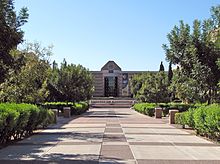
Established in 1984 by the Arizona legislature,[57] the West Valley campus sits on 277.92 acres (1.1247 km2) in a suburban area of northwest Phoenix. The West Valley campus lies about 12 miles (19 km) northwest of Downtown Phoenix, and about 18 miles (29 km) northwest of the Tempe campus. The West Valley campus is designated as a Phoenix Point of Pride[58] and is nearly completely powered by a solar array.[59] The campus serves more than 4,000 students enrolled in at least a single course[5] and offers more than 100 degree programs from the New College of Interdisciplinary Arts and Sciences, the Mary Lou Fulton Teachers College, W. P. Carey School of Business, College of Public Service and Community Solutions, College of Health Solutions, and the College of Nursing and Health Innovation.[60]
Polytechnic campus

Founded in 1996 as "ASU East", the ASU Polytechnic campus serves more than 4,800[5] students and is home to more than 130 bachelor's, master's and doctoral degrees in professional, technical science, humanities, social science and pre-health programs through the W. P. Carey School of Business/Morrison School of Management and Agribusiness, Mary Lou Fulton Teachers College, Ira A. Fulton Schools of Engineering, and College of Integrative Sciences and Arts.[61][62] The campus — a desert arboretum — includes outdoor learning labs and spaces as well as leading-edge simulators and indoor lab spaces to support teaching and research in various fields of study.[48] The 600-acre (2.4 km2) campus is in southeast Mesa, Arizona, approximately 25 miles (40 km) southeast of the Tempe campus, and 33 miles (53 km) southeast of downtown Phoenix. The Polytechnic campus sits on the former Williams Air Force Base[48] and is adjacent to the Phoenix-Mesa Gateway Airport and Chandler-Gilbert Community College (Williams campus).
Downtown Phoenix campus
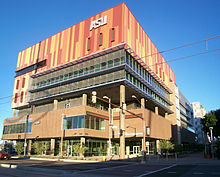
The Downtown Phoenix campus was established in 2006 on the north side of Downtown Phoenix.[63] The campus has an urban design, with several large modern academic buildings intermingled with commercial and retail office buildings. In addition to the new buildings, the campus included the adaptive reuse of several existing structures, including a 1930s era Post Office that is on the National Register of Historic Places.[64] Serving 11,465[5] students, the campus houses the College of Health Solutions,[65] College of Integrative Science and Arts, College of Nursing and Health Innovation,[66] College of Public Service and Community Solutions,[67] Mary Lou Fulton Teachers College, and Walter Cronkite School of Journalism and Mass Communication. In 2013, the campus added the Sun Devil Fitness Center in conjunction with the original YMCA building.[68] ASU's Sandra Day O'Connor College of Law relocated from Tempe to the Downtown Phoenix campus in 2016.[40]
ASU Colleges at Lake Havasu City
In response to demands for lower-cost public higher education in Arizona, ASU developed the small, undergraduate-only college in Lake Havasu City. ASU Colleges are teaching-focused and provide a selection of popular undergraduate majors.[32] The Lake Havasu City campus offers undergraduate degrees at lower tuition rates than other Arizona research universities[69] and a 15-to-1 student-to-faculty ratio.[32]
ASU Online
ASU Online offers more than 150 undergraduate and graduate degree programs through an online platform.[70] The degree programs delivered online hold the same accreditation as the university's traditional face-to-face programs. ASU Online is headquartered at ASU's SkySong campus in Scottsdale, Arizona. ASU Online was ranked in the Top 4 for Best Online Bachelor's Programs by U.S. News & World Report.[71]
Online students are taught by the same faculty and receive the same diploma as on-campus students. ASU online programs allow students to learn in highly interactive environments through student collaboration and through technological personalized learning environments.[72]
In April 2015, ASU Online announced a partnership with edX to form a one of a kind program called the Global Freshman Academy. The program is open to all potential students. The students do not need to submit a high school transcript or GPA to apply for the courses.[73]
As of spring 2017, more than 25,000 students were enrolled through ASU Online.[74] In June 2014, ASU Online and Starbucks announced a partnership called the Starbucks College Achievement Plan. The Starbucks College Achievement Plan offers all benefits-eligible employees full-tuition coverage when they enroll in any one of ASU Online's undergraduate degree programs.[75]
Mayo Clinic School of Medicine, in collaboration with ASU
In 2016, Mayo Clinic and ASU formed a new platform for health care education and research: the Mayo Clinic and Arizona State University Alliance for Health Care.[76] Beginning in 2017, Mayo Clinic School of Medicine students in Phoenix and Scottsdale are among the first to earn a certificate in the Science of Health Care Delivery, with the option to earn a master's degree in the Science of Health Care Delivery through ASU.[77]
Thunderbird Campus
Thunderbird School of Global Management is one of the newest units of "Arizona State University Knowledge Enterprise." The flagship campus was in Glendale, Arizona, at Thunderbird Field No. 1, a former military airfield from which it derives its name, until 2018 when the Thunderbird School relocated to the Downtown area.[78]
Barrett and O'Connor Center
Following a nearly 15-year presence in Washington, D.C., through more minor means, ASU opened the Barrett and O'Connor Center in 2018 to solidify the university's contacts with the capital city. The center houses ASU's D.C.-based academic programs, including the Washington Bureau of the Walter Cronkite School of Journalism and Mass Communication, the Sandra Day O'Connor College of Law Rule of Law and Governance program, the Capital Scholars program, and the McCain Institute's Next Generation Leaders program, among many others. In addition to hosting classes and internships on-site, special lectures and seminars taught from the Barrett & O'Connor Washington Center are connected to classrooms in Arizona through video-conferencing technology.[79] The Barrett and O'Connor center is located at 1800 I St NW, Washington, DC 20006, close to the White House.
ASU California
ASU operates its "California Center" in Los Angeles at the Herald Examiner Building.[80] The center offers undergraduate and graduate degree programs, executive education, workshops and seminars.[81] In 2022, ASU acquired a small nonprofit college, Columbia College Hollywood, and renamed it California College of ASU.[82] In 2023, ASU reached an agreement with the for-profit Fashion Institute of Design and Merchandising to take over some of its academic programs, creating ASU FIDM.[83]
Academics
Admissions
Parts of this article (those related to 2017 data) need to be updated. (April 2022) |
| Fall 2019 | Fall 2018 | Fall 2017 | Fall 2016 | Fall 2015 | |
|---|---|---|---|---|---|
| Applicants | 34,188 | 26,869 | 34,181 | 33,466 | 33,575 |
| Admits | 29,562 | 22,779 | 28,096 | 27,111 | 27,452 |
| % Admitted | 86.5 | 84.8 | 82.2 | 81.0 | 81.8 |
| Enrolled | 10,044 | 8,861 | 10,278 | 10,415 | 10,391 |
| Avg. HS GPA | 3.53 | 3.54 | 3.53 | 3.49 | 3.48 |
| Fall 2021 | Fall 2020 | |
|---|---|---|
| Applicants | 61,603 | 53516 |
| Admits | 54,329 | 47290 |
| % Admitted | 88.2 | 88.3 |
| Enrolled | 14,250 | 12,677 |
| Avg. HS GPA | 3.54 | 3.52 |
As of August 2022, ASU had a systemwide enrolled student population (both in-person and online) of 140,759, a 4% increase over the systemwide total in 2021.[88] Out of that total, approximately 79,000 students were enrolled in-person at one of the ASU campuses, an increase of 3.2% from 2021.[88] Just over 61,000 students were enrolled in ASU Online courses and programs as of August 2022, an increase of roughly 7% in online student enrollment from the previous year.[88]
According to the U.S. News & World Report, for the 2022–2023 academic year ASU admitted 88% of all freshman applicants and classified the school's admissions in the “selective” category.[89] The average high school GPA of incoming first-year students for the 2022–23 academic year was 3.54.[86]
Barrett, The Honors College is ranked among the top honors programs in the nation.[90] Although there are no set minimum admissions criteria for Barrett College, the average GPA of Fall 2017 incoming freshmen was 3.78, with an average SAT score of 1380 and an average ACT score of 29.[90] The Honors college has 7,236 students, with 719 National Merit Scholars.[90]
ASU enrolls 10,268 international students, 14.3% of the total student population.[3] The international student body represents more than 150 nations.[91] The Institute of International Education ranked ASU as the top public university in the U.S. for hosting international students in 2016–2017.[92]
In June 2022, Arizona State University was designated a Hispanic-serving institution (HSI) by the United States Department of Education in recognition of the fact that for the first time in the school's history, during the Fall Semester of 2021 Hispanic students comprised over 25% of the university's total undergraduate enrollment.[93]
Academic programs
| Fall 2021 | Fall 2020 | Fall 2019 | Fall 2018 | Fall 2017 | Fall 2016 | Fall 2015 | Fall 2014 | Fall 2013 | |
|---|---|---|---|---|---|---|---|---|---|
| Undergraduate | 107,425 | 103,609 | 96,726 | 89,888 | 83,544 | 79,442 | 74,139 | 67,498 | 62,082 |
| Graduate | 28,304 | 25,179 | 23,225 | 21,361 | 19,986 | 18,704 | 17,183 | 15,762 | 14,646 |
| Total campus-based enrollment | 77,881 | 74,795 | 75,698 | 73,875 | 72,947 | 72,362 | 71,305 | 69,511 | 66,770 |
| Online | 53,933 | Zdroj:https://en.wikipedia.org?pojem=Arizona_State_University

